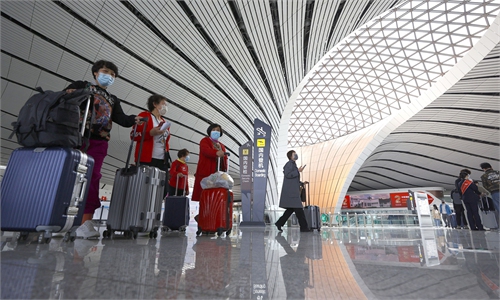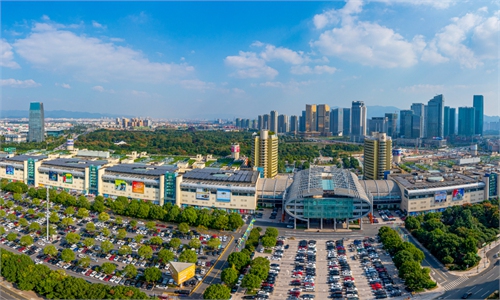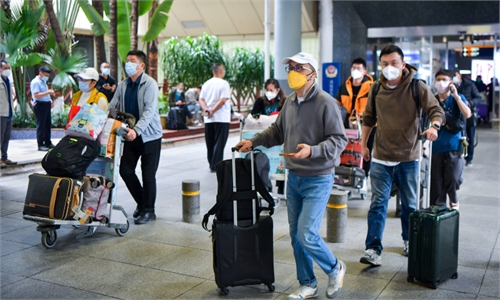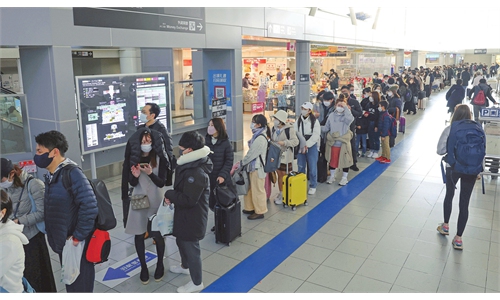China gets off to a good start with new year tourism rebound, boosts market confidence for 2023 economic recovery

Crew members celebrate the start of full operations on the high-speed railway linking Yinchuan, Northwest China's Ningxia Hui Autonomous Region with Lanzhou, Northwest China's Gansu Province on December 29, 2022. With a designed speed of 250 kilometers per hour, the new line will cut the travel time between the two cities by over five hours. Photo: cnsphoto
In the first holiday season after China adjusted its coronavirus management measures, the country ushered in a bulge of tourism demands across different regions, as the Chinese people unleash their pent-up demands for travel in what experts said makes a good start for economic rebound in 2023.At multiple tourist destinations in China, the number of tourists has seen a sharp rebound on a yearly basis. On the first day of 2023, more than 10,000 tourists climbed the Huangshan Mountain in East China's Anhui Province, up nearly 58 percent compared with the first day of 2022. Many tourists posed in front of the mountain's famous "Greeting Pine" to celebrate the first sunrise of the new year.
Such scenes are everywhere in China in the three-day New Year's Day holidays. In Beijing's renowned tourist site Forbidden City, travel reservations had hit the upper limit of 30,000 people on Sunday, the second day of the holidays, according to a CCTV report.
In Shanghai, the familiar scene of families elbowing their way through crowds on the Nanjing Road and near the Bund area to celebrate the new year is back again. On the New Year's Eve, the total passenger flow of the Bund's waterfront area was 308,000, with an instantaneous peak of 64,000 people, nearly double that of December 31, 2021 and amounting to about 70 percent of the New Year's Eve in 2019, a report by portal kankanews.com noted.
In the eyes of industrial practitioners and experts, such scenarios are not surprising, as they reflect the resilience and flexibility of China's economy, the consumption sector in particular.
"The bottleneck of China's offline consumption caused by repeated coronavirus strikes in the past three years is being run over, and chances are great that China's consumption sector will usher in an inflection point of comprehensive recovery in the near future," Chen Jia, an independent research fellow on international strategy, told the Global Times on Monday.
Strong rebound
Data provided by multiple tourism platforms to the Global Times has showed that China's tourism rebound during the New Year's Day holidays is very strong, if not totally full-fledged, sending a clear signal that the domestic tourism sector is recovering in a better-than-expected manner.
According to a report sent by ly.com to the Global Times, hotel reservations during the recent New Year's Day holidays have surged by 32 percent compared with the level in 2020. In particular, hotel reservations in a number of destinations such as Luoyang in Central China's Henan Province and Xishuangbanna in Southwest China's Yunnan Province have surged more than 10 times on a yearly basis after those regions shake off influence from the coronavirus outbreaks.
Meanwhile, air ticket bookings also surged by 2 percent during this New Year's Day holidays compared with the holiday season in 2020, ly.com report noted.
Many cities that recently underwent relatively severe coronavirus blows have recovered quickly in terms of travel sentiment. According to data compiled by mafengwo.cn, Beijing, Guangzhou and Shanghai are among the top five cities with the highest travel enthusiasm.
Data in a report sent by qunar.com to the Global Times also showed that travel bookings departing from Guangzhou and Shanghai during this New Year's Day holidays have surpassed the corresponding time in the previous year.
According to information revealed by China Railway, people made more than 4.74 million trips by the railway system on Sunday. During 2022's New Year's Day holidays, a total of 21.7 million trips were made by the railway.
The rebound in tourism demands came after China rolled out 10 new measures to ease coronavirus management, including lifting COVID testing and health code requirements for domestic cross-regional travelers. The country also dropped cross-border COVID-19 travel restrictions.
Xu Xiaolei, marketing manager at China's CYTS Tours, told the Global Times on Monday that the tourism recovery after China adjusted COVID measures has been "relatively evident," particularly in terms of medium or short-distance travel.
He revealed that hotel bookings for Beijing WTown, a tourist spot in Beijing's Miyun district, were almost full during this New Year's Day holidays except for certain suites.
"This is not commonly seen in the past three years of coronavirus period," he said.
This trend of recovery also made Xu more confident of a more evident tourism rebound during the upcoming Spring Festival holidays, such as tourism spots in southern/eastern China regions like Hainan and ice travel in northern China regions.
But he is still a bit reserved when it comes to the recovery of cross-border travel, as this sector needs to roll out more supportive policies and further recovery of consumption confidence, but Chinese tourists might start to show up gradually in Southeast Asian destinations, as well as Hong Kong and Macao in the coming holidays, he said.
Economic mainstay
Experts also noted that the recent tourism rebound makes a good start for China's economy in 2023, as it signals the strong growth momentum of China's consumption sector, which is set to become a primary engine of this year's economic performance.
Tian Yun, a veteran economist and former vice director of the Beijing Economic Operation Association, told the Global Times on Monday that the recent consumption recovery has been "much earlier" than market expectations.
"The market used to think that China needs about one full quarter to adjust its economy, but now the situation seems to far exceed what people had expected," he said.
This in turn proves the fact that China's consumption potentials are only restricted by external environment, instead of being hurt fundamentally during the past several years, he said.
On the other hand, as other pillars of economic growth are burdened by uncertain factors such as US' monetary policies and local government debt pressure, consumption is believed to be the major momentum for this year's economic growth.
"The strength of China's consumption rebound decides the height of China's economic performance this year. It [the consumption sector] is going to be the No.1 force that drives up the economy this year, likely accounting for more than 70 percent of total GDP," Tian said.
In a larger sense, experts also stressed that China's consumption sector will play a pivotal role in driving up the global economy, as at a time when many other countries are presenting gloomy economic prospects, the recovery of Chinese demands will make all the difference for overseas consumption sector as well.
"Whether in terms of driving up confidence, boosting connectivity between global industrial chains and consumption market or stabilizing global economy, the importance of China's consumption sector for the global economy is without rival," Chen said.
He cited the example of tourism market, saying that China's optimizing of cross-border travel policies might help the global tourism industry recover to pre-COVID levels in 2023.
Tian also noted that if China's consumption sector could grow by 5 or 6 percent in the first quarter of 2023, that could make the world more confident of China's whole-year economic performance, which will in turn affect global capital flow direction to a relatively large extent.




